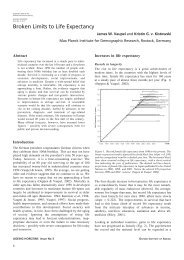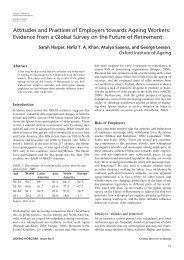Global Ageing: What is at stake? - by Börsch-Supan - Oxford Institute ...
Global Ageing: What is at stake? - by Börsch-Supan - Oxford Institute ...
Global Ageing: What is at stake? - by Börsch-Supan - Oxford Institute ...
Create successful ePaper yourself
Turn your PDF publications into a flip-book with our unique Google optimized e-Paper software.
tivity would need increase <strong>by</strong> 40%, probably an unreal<strong>is</strong>ticfigure.The variability range for th<strong>is</strong> forecast <strong>is</strong> large and almostentirely depends on future labour force particip<strong>at</strong>ion of theyoung, the elderly and the female. In most pessim<strong>is</strong>ticscenarios of unchanging labour force particip<strong>at</strong>ion, theimpact of the declining support r<strong>at</strong>io <strong>is</strong> huge. On the otherhand, in an optim<strong>is</strong>tic scenario of Denmark-style labourmarket reforms, the shift in the age structure <strong>is</strong> compens<strong>at</strong>edfor almost entirely <strong>by</strong> the increase in particip<strong>at</strong>ionr<strong>at</strong>es.Th<strong>is</strong> example bears several lessons for policy in times ofglobal ageing. First, the huge variability of the projectionsand the leverage of employment on GDP make clear th<strong>at</strong>it <strong>is</strong> important to better understand how public policy caninfluence labour force particip<strong>at</strong>ion r<strong>at</strong>es. Structuralreforms such as educ<strong>at</strong>ion reform and pension reform havepotentially huge “side-effects” on GDP growth throughtheir impact on employment, over and above the oftenmore prominently d<strong>is</strong>cussed impacts on social budgets.Second, the above example shows how strongly the differentialforce of global ageing depends on to the extent towhich an increasing quality of labour will compens<strong>at</strong>e forthe decreasing quantity of labour. “Side effects” of structuralreforms on productivity may in the long-run domin<strong>at</strong>eany direct but st<strong>at</strong>ic effects, because they change thegrowth p<strong>at</strong>h of the economy.Not only the size but also the age structure of the workingpopul<strong>at</strong>ion will change radically in the coming decades.We again use Germany as an example for how dram<strong>at</strong>icthe change will be. The modal age of the German workforce in the year 2000 was around age 36; in 2010, th<strong>is</strong>peak age will increase to 46 years; and a further 10 yearsl<strong>at</strong>er it will be 54 years. The ba<strong>by</strong> boomers then retire –the age d<strong>is</strong>tribution curve fl<strong>at</strong>tens out and changes verylittle in the following decades.Th<strong>is</strong> fundamental change in the age structure of theworking popul<strong>at</strong>ion will have profound effects on themicroeconomics and the sociology of the labour market.The most important – and most controversial – aspect <strong>is</strong>the potential effect on labour productivity. If labourproductivity <strong>is</strong> age dependent, a shift in the age structurewill also bring about a change in aggreg<strong>at</strong>e productivity,even if age-specific productivity were to remain constant.We know little about the size of these effects. R<strong>at</strong>her, moreresearch on age-specific productivity <strong>is</strong> needed to betterunderstand whether ageing economies will suffer from aproductivity decline, amplifying the effects of a shrinkingquantity of labour. At the very least, however, we understandth<strong>at</strong> further educ<strong>at</strong>ion increases productivity – andherein lies an important policy message: prevent all actionsth<strong>at</strong> make further educ<strong>at</strong>ion less <strong>at</strong>tractive, and strengthenall steps th<strong>at</strong> increase the investment value of further educ<strong>at</strong>ion– such as a l<strong>at</strong>er retirement age.Interactions between labour, product andcapital marketsThe labour market <strong>is</strong> not insul<strong>at</strong>ed from other markets. It<strong>is</strong> not only directly affected <strong>by</strong> popul<strong>at</strong>ion ageing, but alsoindirectly <strong>by</strong> ageing-induced changes in product and capitalmarkets.Product demand will change, since an older popul<strong>at</strong>ion ofconsumers has different preferences and needs than ayounger popul<strong>at</strong>ion. Consumption demand may also declinefor <strong>at</strong> least two reasons. First, because GDP per capita willdecline in the face of a shrinking labour force unless th<strong>is</strong><strong>is</strong> offset <strong>by</strong> higher capital input and productivity. Secondand more subtly, it <strong>is</strong> likely th<strong>at</strong> more retirement incomecomes from asset income which fluctu<strong>at</strong>es more than annuitizedpension and labour income. Th<strong>is</strong> will increaseprecautionary savings and depress consumption, given afixed level of income.Consumption behavior changes with increasing age. Forexample, spending on goods in the group “transport andcommunic<strong>at</strong>ion” falls over the life cycle, while goods inthe “health and hygiene” group, as well as costs of shelter,account for a growing share of older households’ budgets.Hence, if the age d<strong>is</strong>tribution of an economy <strong>is</strong> changing,the composition of consumption will change accordingly.Most notably the aggreg<strong>at</strong>ed expenditure on health willincrease during the ageing process while the correspondingspending on transport will decline.Changing product demand will then precipit<strong>at</strong>e shifts insectoral labour demand. Employment in the health sectorwill increase; it will decline in the transport sector. Someestim<strong>at</strong>es suggest th<strong>at</strong> more than a sixth of all workers willneed to change their jobs due to popul<strong>at</strong>ion ageing.Labour supply <strong>is</strong> also affected <strong>by</strong> capital market fluctu<strong>at</strong>ions.The more retirement income <strong>is</strong> provided throughfunded pension income (e.g., 401k plans or other individualaccounts invested in the stock market), stock marketperformance will, <strong>at</strong> the margin, affect the retirement dec<strong>is</strong>ionof workers as well as their consumption demand.Understanding th<strong>is</strong> mechan<strong>is</strong>m <strong>is</strong> important for analyses ofglobal ageing since it may substantially amplify capitalmarket d<strong>is</strong>turbances. Stock markets have exhibited hugeswings, and we do not fully understand how bubblesemerge and even less how to predict and prevent them.Th<strong>is</strong> topic has a clear political dimension since the flexibilityof choosing the retirement age <strong>is</strong> a core transm<strong>is</strong>sionmechan<strong>is</strong>m for these interactions between the capitalmarket on one side and labour and product markets on theother side.Capital marketsCapital markets play a crucial role in global ageing sincecapital <strong>is</strong> the factor which moves with the least frictionsAGEING HORIZONS Issue No 4OXFORD INSTITUTE OF AGEING4




![ORAL PRESENTATIONS [pdf] - Oxford Institute of Ageing](https://img.yumpu.com/37918222/1/184x260/oral-presentations-pdf-oxford-institute-of-ageing.jpg?quality=85)





